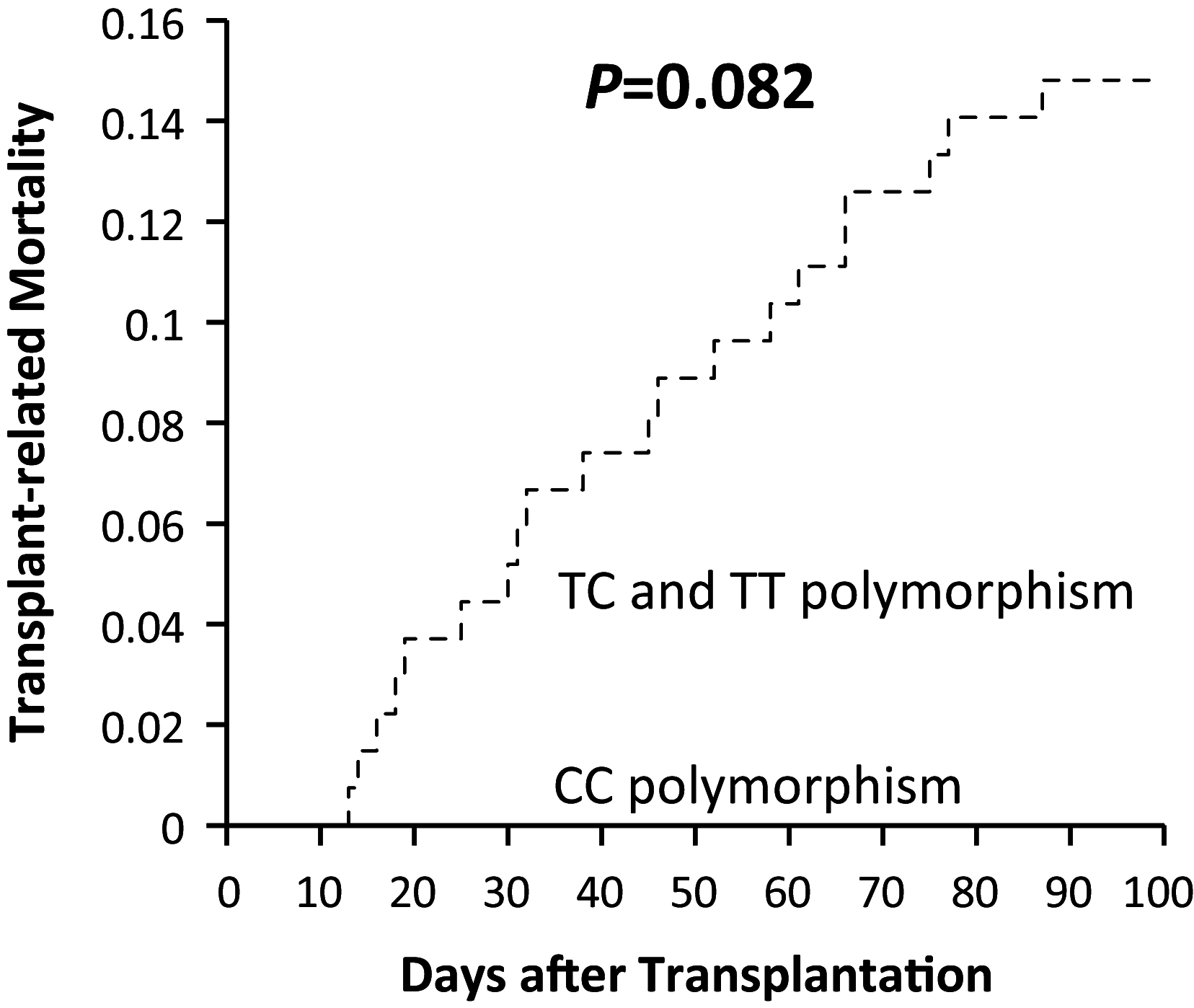Heparanase polymorphisms: influence on incidence of hepatic sinusoidal obstruction syndrome in children undergoing allogeneic hematopoietic stem cell transplantation
- PMID: 25335953
- PMCID: PMC11823510
- DOI: 10.1007/s00432-014-1857-2
Heparanase polymorphisms: influence on incidence of hepatic sinusoidal obstruction syndrome in children undergoing allogeneic hematopoietic stem cell transplantation
Abstract
Purpose: Sinusoidal obstruction syndrome (SOS) is a life-threatening early complication after hematopoietic stem cell transplantation (HSCT), and until now, examinations about the influence of genetic risk factors are extremely rare. The purpose of this study was to identify an association between heparanase (HPSE) single nucleotide polymorphisms (SNPs) and SOS in children undergoing allogeneic HSCT.
Methods: We retrospectively analyzed the distribution of the both HPSE SNPs rs4693608 and rs4364254 and the occurrence of SOS after allogeneic HSCT in 160 children with malignant and non-malignant diseases.
Results: Patients with HPSE genotypes GG or AG of rs4693608 (G>A) had a significantly reduced incidence of SOS on day 100 after HSCT compared to patients with genotype AA (4.7 vs. 14.3 %, P = 0.038). In addition, incidence of SOS in patients with genotype CC or CT of rs4364254 (C>T) was significantly decreased in comparison with patients with genotype TT (2.3 vs. 14.7 %, P = 0.004). Interestingly, no patient with genotype CC developed SOS. Because both SNPs co-occur in vivo, we generated subsets: AA-TT, GG-CC, and a group with remaining SNP combinations. We found significant differences between all three patient groups (P = 0.035). Patients with AA-TT showed the highest incidence of SOS (16.7 %), while SOS did not appear in patients with GG-CC (0 %) and residual combinations were numerically in-between (4.9 %). An impact caused by main patient and donor characteristics, established risk factors for SOS, and conditioning regimen could be excluded in multivariate analyses.
Conclusions: HPSE polymorphisms turned out to be significant independent risk factors (P = 0.030) for development of SOS and should be evaluated in further trials.
Figures



Similar articles
-
CTLA-4 polymorphisms: influence on transplant-related mortality and survival in children undergoing allogeneic hematopoietic stem cell transplantation.J Cancer Res Clin Oncol. 2018 Mar;144(3):587-592. doi: 10.1007/s00432-018-2578-8. Epub 2018 Jan 15. J Cancer Res Clin Oncol. 2018. PMID: 29335768 Free PMC article.
-
Diagnostic accuracy of liver stiffness measurement for the diagnosis of veno-occlusive disease/sinusoidal obstruction syndrome after hematopoietic stem cell transplantation (HSCT), the ELASTOVOD STUDY: an investigator-initiated, prospective, multicentre diagnostic clinical trial.Bone Marrow Transplant. 2025 Jul;60(7):978-993. doi: 10.1038/s41409-025-02570-w. Epub 2025 Apr 19. Bone Marrow Transplant. 2025. PMID: 40253530 Clinical Trial.
-
Analysis of laboratory parameters before the occurrence of hepatic sinusoidal obstruction syndrome in children, adolescents, and young adults after hematopoietic stem cell transplantation.J Cancer Res Clin Oncol. 2024 Jan 11;150(1):9. doi: 10.1007/s00432-023-05561-w. J Cancer Res Clin Oncol. 2024. PMID: 38206490 Free PMC article.
-
First-line allogeneic hematopoietic stem cell transplantation of HLA-matched sibling donors compared with first-line ciclosporin and/or antithymocyte or antilymphocyte globulin for acquired severe aplastic anemia.Cochrane Database Syst Rev. 2013 Jul 23;2013(7):CD006407. doi: 10.1002/14651858.CD006407.pub2. Cochrane Database Syst Rev. 2013. PMID: 23881658 Free PMC article.
-
Interventions for prophylaxis of hepatic veno-occlusive disease in people undergoing haematopoietic stem cell transplantation.Cochrane Database Syst Rev. 2015 May 27;2015(5):CD009311. doi: 10.1002/14651858.CD009311.pub2. Cochrane Database Syst Rev. 2015. PMID: 26017019 Free PMC article.
Cited by
-
Genetic Predictors for Sinusoidal Obstruction Syndrome-A Systematic Review.J Pers Med. 2021 Apr 26;11(5):347. doi: 10.3390/jpm11050347. J Pers Med. 2021. PMID: 33925809 Free PMC article. Review.
-
Role of Pharmacogenetics in Hematopoietic Stem Cell Transplantation Outcome in Children.Int J Mol Sci. 2015 Aug 10;16(8):18601-27. doi: 10.3390/ijms160818601. Int J Mol Sci. 2015. PMID: 26266406 Free PMC article. Review.
-
The use of defibrotide in blood and marrow transplantation.Blood Adv. 2018 Jun 26;2(12):1495-1509. doi: 10.1182/bloodadvances.2017008375. Blood Adv. 2018. PMID: 29945939 Free PMC article. Review.
-
Correlation between heparanase gene polymorphism and susceptibility to endometrial cancer.Mol Genet Genomic Med. 2020 Oct;8(10):e1257. doi: 10.1002/mgg3.1257. Epub 2020 Sep 1. Mol Genet Genomic Med. 2020. PMID: 32869952 Free PMC article.
-
Biomarkers for hepatic sinusoidal obstruction syndrome after hematopoietic cell transplantation.Blood Res. 2015 Sep;50(3):123-5. doi: 10.5045/br.2015.50.3.123. Epub 2015 Sep 22. Blood Res. 2015. PMID: 26457275 Free PMC article. No abstract available.
References
-
- Barker CC, Butzner JD, Anderson RA, Brant R, Sauve RS (2003) Incidence, survival and risk factors for the development of veno-occlusive disease in pediatric hematopoietic stem cell transplant recipients. Bone Marrow Transpl 32(1):79–87 - PubMed
-
- Benimetskaya I, Wu S, Voskresensky AM, Echart C, Zhou JF, Shin J et al (2008) Angiogenesis alteration by defibrotide: implications for its mechanism of action in severe hepatic veno-occlusive disease. Blood 112(10):4343–4352 - PubMed
-
- Bulley SR, Strahm B, Doyle J, Dupuis LL (2007) Defibrotide for the treatment of hepatic veno-occlusive disease in children. Pediatr Blood Cancer 48(7):700–704 - PubMed
-
- Carreras E, Díaz-Beyá M, Rosiñol L, Martínez C, Fernández-Avilés F, Rovira M (2011) The incidence of veno-occlusive disease following allogeneic hematopoietic stem cell transplantation has diminished and the outcome improved over the last decade. Biol Blood Marrow Transpl 17(11):1713–1720 - PubMed
-
- Chalandon Y, Roosnek E, Mermillod B, Newton A, Ozsahin H, Wacker P et al (2004) Prevention of veno-occlusive disease with defibrotide after allogeneic stem cell transplantation. Biol Blood Marrow Transpl 10(5):347–354 - PubMed
MeSH terms
Substances
LinkOut - more resources
Full Text Sources
Other Literature Sources

